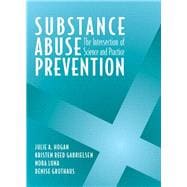
Note: Supplemental materials are not guaranteed with Rental or Used book purchases.
Purchase Benefits
What is included with this book?
1. Introduction —Julie Hogan.
Evolution and Training of the Preventative Discipline.
Attitudes about Alcohol, Tobacco, and other Drugs.
Definitions of Use, Abuse, and Dependence/Addiction.
Justification for Theory.
United States History of Substance Abuse Prevention.
A Timeline of Prevention.
Building Blocks for the Prevention Profession.
2. Prevention Research—Julie Hogan.
The Risk and Protective Factor Theory.
The Resiliency Approach.
The Developmental Assets Approach.
The Six CSAP Strategies.
3. Prevention Program Planning—Kristen Reed Gabrielson.
Step 1: Asses the Readiness of the Community and Mobilize for Action.
Step 2: Assess the Levels of Risk Factors and Protective Factors in the Community.
Step 3: Translate Data into Priorities.
Step 4: Examine the Resources in the Community that are Reducing Risk Factors.
Step 5: Select a Target Population.
Step 6: Apply “Best Practices” and “Guiding Principles.”
Step 7: Evaluate.
4. Facts about Drugs— Nora Luna.
Models of Addiction.
Central Nervous System Depressants.
Opiates.
Central Nervous Stimulants.
Hallucinogens.
Cannabinols.
Steroids.
Inhalants.
Gateway Drugs.
Trends in Drug Use.
5. The Cultural Context and Ethics of Prevention—Denise Grothaus.
Culture Defined.
Elements of Culture.
Types of Culture.
Cultural Competence.
Working in the Community.
Ethics in Prevention.
6. Incorporating Human Development Theory into Prevention—Denise Grothaus.
Abraham Maslow's Hierarchy of Needs.
Erik Erikson's Psychosocial Developmental Stages.
Jean Piaget's Cognitive-Developmental Stages.
Medicine Wheel.
7. The Media and Prevention—Nora Luna.
Media Advocacy.
Media Literacy.
Social Marketing.
8. The Logic Model and Evaluation—Kristen Reed Gabrielson.
Logic Model.
Developing Evaluation Questions.
Internal or External Evaluations?
Developing a Design to Answer Evaluation Questions.
Developing Methods to Carry out the Evaluation Design.
Analyzing Evaluation Data.
Conducting the Evaluation.
Using the Answers to the Evaluation Questions.
9. Communication Strategies—Julie Hogan.
Communication Models.
Listening.
Public Speaking Skills.
Group Facilitation and Leadership Skills.
Leadership Skills.
10. Grant Writing—Kristen Reed Gabrielson.
Introduction to Grant Writing in Prevention.
Motivations of Grant Makers.
Preliminary Steps to Grant Writing.
Writing Shorter Letter Proposals.
Writing Long Proposals.
General Grant-Writing Tips.
What Happens Next?
11. Bringing it all Together—Julie Hogan.
Challenges in Applying Science-Based Prevention Principles to Prevention Programs.
Chapter Summary.
Grant Applications.
Discussion.
Appendix A: Community Readiness Survey.
Appendix B: Validated Archival Indicators.
Appendix C: Three Case Studies in Prevention.
Appendix D: Case Studies in Prevention. Closing the Gap Between Research and Practice: Lessons of the First Three Years of CSAP's National CAPT System 1997-2000.
The New copy of this book will include any supplemental materials advertised. Please check the title of the book to determine if it should include any access cards, study guides, lab manuals, CDs, etc.
The Used, Rental and eBook copies of this book are not guaranteed to include any supplemental materials. Typically, only the book itself is included. This is true even if the title states it includes any access cards, study guides, lab manuals, CDs, etc.